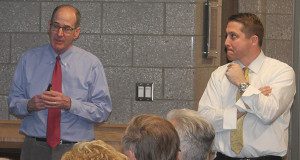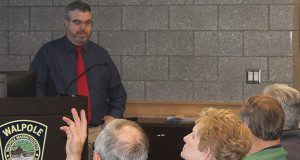[ccfic caption-text format="plaintext"]
By James Kinneen
Hometown Weekly Reporter
After extensive studying and planning, Weston & Sampson unveiled their proposed field construction plan for the 1A fields in Walpole and took questions from concerned residents. The planned complex would include 280 total parking spots, a jogging path around the fields, a playground, a possible splash park, and a building for concessions, restrooms and storage purposes.
The main item the presentation conveyed to those in attendance was that a synthetic field is vital to the area.
While other issues were raised - like whether the area should have a splash pad or what kind of playground equipment could be used - Weston & Sampson Vice President Gene Bolinger was very clear that the synthetic field is paramount. He noted that synthetic turf fields “have a much longer window for when they’re available to use. They can be used during inclement weather, and weather is becomingly increasingly unpredictable. This fall, school sports were a disaster. The natural fields could hardly dry out.” He further argued that by having both the synthetic field and the other planned fields, other area playing fields in both Walpole and other communities would be less burdened by the sheer number of activities.
When they were informed that there were a few “old trail networks” running through the forest, a few residents wanted to know what the history was before the forest was cleared for the fields. One resident was very concerned that the bathrooms were gendered, not unisex, and a few residents expressed concern over what would happen in case of a lighting storm.
Other issues that arose included the necessity of security cameras, the speed limits on nearby streets, and when the proposed building for concessions and bathrooms would be open.
Bolinger made it clear that the fields were designed for the younger children of Walpole, not for the high school teams, and that residents would also be more than welcome to use them at their leisure.
While Bolinger noted that there would be nets to keep soccer balls, especially, from flying into the street, he expressed that he did not want to “overdue it with fences” to maintain the aesthetic quality of the area. It was also mentioned that a local cricket team hoped they would be able to use the field, though that was mentioned in passing.
While the presentation was extensive and showed the extent of the proposed project, one big thing was missing: the price. Neither the company, nor the town’s representatives had those numbers yet, but promised they would be coming in the future.
When a town resident asked where the money for this would be coming from, Town Administrator James Johnson said, “we’re working on it,” while noting that at this time, they had not sought funding from the state.
























